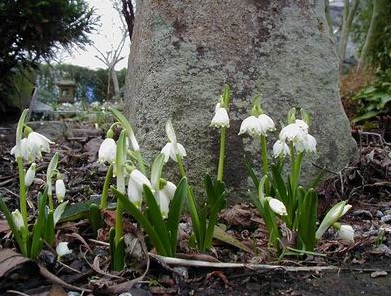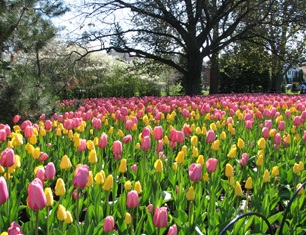Categories
Calendars
Guides
Reviews
Archive
Gallery
Articles
Ask Our Gardening Expert
Landscaping with Bulbs and Corms
Bulbs and corms add interest for only one season and lie unnoticed for the rest of the year. Bulbous plants are invaluable as border and container plants at a time of year when there is little else on the ground and are ideal for naturalising in grass or under deciduous trees. Bulbs can be left from year to year, their foliage decomposing after replenishing and renewing the underground parts, to be followed in succession by herbaceous plants and shrubs. Bulbs and corms maybe lifted and stored after flowering, making them useful for small gardens and containers.
Leucojum showing early
Spring and early summer are the times when bulbous plants are most evident, but many flower at other times outdoors or in a controlled environment. Cyclamen, crocus and snowdrops are early bloomers and the larger gladioli and lilies are much later, daffodils and tulips somewhere between.
Bulbs are easiest to grow in well-drained soil and many will thrive in all but the deepest shade. Many come from Mediterranean climates and need sun, heat and dryness. Woodland bulbs will tolerate moist soil and light shade. It is generally agreed that bulbs are most effective when planted in groups of the same species and variety.
Formal planting of tulips
Bulbs can be used to fill in between the permanent plantings of the herbaceous border. Spring flowerers provide colour when the herbaceous perennials are just emerging and taller plants, like lilies and gladiolus, provide a contrast in height and form through the summer into autumn. Planting in a mixed border extends the flowering season and brings the border to life.
A very mixed planting using tulips with herbaceous perennials
Pots, window boxes and other containers must not be overlooked. Plant a container with a single colour to give a mass effect and then group the containers for spectacular show. Containers with fragrant hyacinth or daffodils gain most appreciation and are effective near well used areas, close to entrance ways, beside steps or in yards or where people pause a moment. Layering bulbs in a pot allows you to fill a pot to the brim, plant narcissi below tulips and then crocus in the top layer. As in flower beds, once bulbs have flowered, they can be lifted to make way for annuals. The foliage can be allowed to dry and the bulbs stored for replanting in the autumn. Choose plants in proportion to the container. In window boxes, plant bulbs of different height and colour to achieve an effect of contrasting ‘layers’. Mix with other plants, perhaps trailing annuals or perennials.
Extend the season with pansies
Planting bulbs and corms opens new possibilities to both new and experienced gardeners. Another level of excitement and anticipation can be experienced, planting the season before and seeing the result. At the end of winter, the first green shoots appear when the garden appears almost lifeless, followed by the blooms. In gardening, there are no rules to follow other than to please yourself and by all means plant where you think things should go rather than follow strict procedures on what is regarded as good taste.
Planting bulbs and corms is an easy way making a cheerful show in a short time in the garden when moving into a new home or to add life to an existing garden after the greyness of winter.
In formal settings, spring flowering bulbs are excellent for mass plantings in beds where annuals are to be planted later on. They can be lifted and stored whilst dormant and used again the following year. The classic bulbs for bedding are hyacinths and tulips. They can be of one type, planted in blocks of colour, or in mixed groups to provide a longer display. Companion planting with forget-me-not or wallflowers in contrasting colours is effective. Visit public parks and gardens at flowering times to get some ideas on colour combinations that work.

